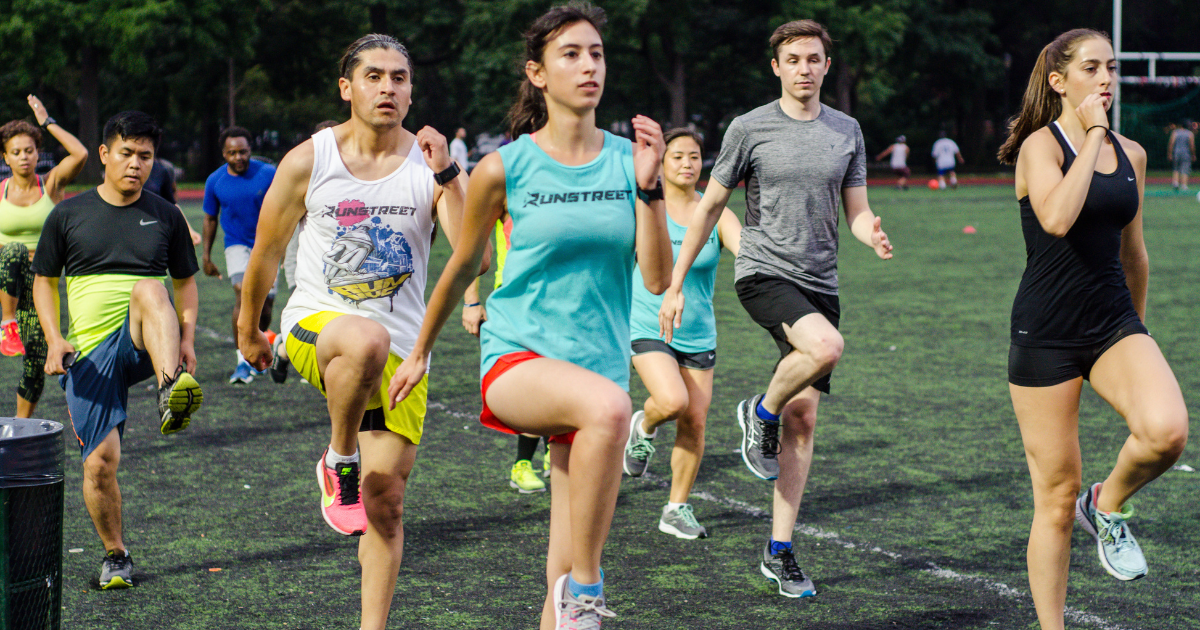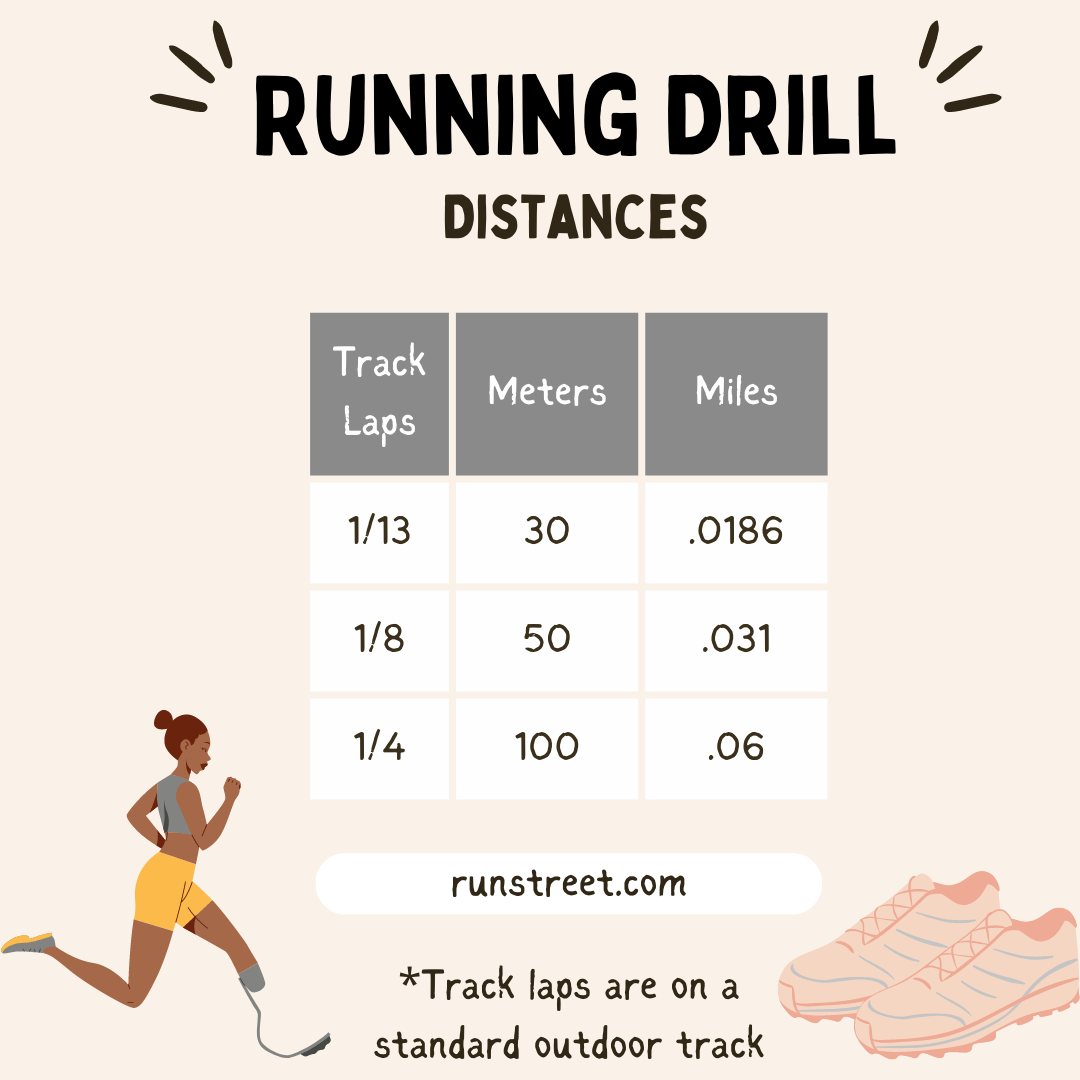10 Running Drills to Become a Better Runner
Running drills at the track. Photos by Marques Jackson Photography.
By Marnie Kunz, NASM-certified trainer, USATF- RRCA-certified run coach
These 10 running drills will help you become a better runner by improving your form and speed. Whether you want to get faster, reduce your risk of injuries, or run your best race time, these exercises will help get you there. As a running coach and trainer, I’ve used these speed and running form drills to help runners get faster for races ranging from the mile to the marathon. These exercises will improve your running mechanics so you can master good running form.
Related: 10 Plyometric Exercises for Speed
What are Running Drills?
Running drills are exercises that prepare your muscles for specific movement patterns used in running. These drills train your neurons to fire efficiently, committing movements you use when running to memory. Running drills improve your coordination and running form and will help you become a stronger, more efficient runner so you can run injury-free.
Adding these exercises to your running routine will improve your body’s range of motion and reduce your chances of getting running injuries while training your body to run more efficiently. Everyone from new runners to sprinters to advanced distance runners can benefit from these running drill workouts.
If you need a training plan to help you crush your next big race, visit our Runstreet Training Center for the best options to deliver fast times and unforgettable races.
How to Do Running Drills
Do running drills on a flat, even surface such as a track or football field. You can also do drills on a flat road if your workout or race will be on the road. Do each running drill for about 30 meters to start.
Once you master good form, you can do these drills for 50 meters. You can measure your running drill distance with a GPS running watch or app. Do 2 sets of each drill.
As for when to do drills, you can do them before or after your runs, depending on your goals. Do running drills after a regular base run to improve your running form. Running drills are also especially beneficial to prime your body for running fast, so you can do them as part of your warm-up before a race or speed workout.
I recommend doing these running drills twice a week to improve your running speed, balance, and stability. You don’t have to do all 10 drills at once, but pick at least 2 or 3 to do after or before your running workout for injury prevention and better running form.
10 Best Drills to Become a Better Runner
1. A Skip
The A skip is one of the best drills to activate some of your primary running muscles - the hamstrings and glutes. These are beginner-friendly exercises that all levels of runners can do.
How To Do It:
Begin from a standing position.
Do an exaggerated skip, bringing one knee up at a time. Drive one knee up to waist level while skipping on the ball of your other foot.
Alternate legs and keep your posture upright, with your shoulders back and head looking forward.
Swing your arms from front to back with elbows bent, the same as you would when running. Swing your opposite arm forward to the lead leg, so if your right leg drives up for a skip, bring your left arm forward and right arm back.
2. B Skip
B skips are an excellent way to further your drill training. These use the basic premise of the A skip and add an extra step. B skips help improve your running efficiency and reduce overstriding.
How To Do It:
Stand with your chest up and shoulders back, and head looking forward.
Skip up onto the ball of one foot while bringing your knee of your opposite leg up as if doing an A skip.
Straighten your raised leg after bringing your knee up.
Use your opposite arm to drive forward on the opposite side of your lifted leg.
Bend your knee, return to the starting position, and repeat on the other side.
3. Butt Kicks
Butt kicks are beginner-friendly running drills that target your hamstrings and glutes and improve your running power. This exercise also helps loosen your quads and trains your legs to move quickly.
How To Do It:
Begin from a standing position with your chest up and looking forward.
Slowly move forward as you bring each leg behind you to “kick” your butt.
Move your legs quickly, alternating to “kick” quickly and exaggeratedly on each side.
4. High Knees
High knees is another beginner-friendly drill that helps prepare your hamstrings, glutes, calves, and hip flexors for running. This running drill also helps improve your running form by training you to lift your knees and not trudge along.
How To Do It:
Begin from a standing position.
Slowly move forward as you lift each knee to at least waist height, exaggerating the vertical motion to bring each knee up as high as possible toward your chest.
You can also do this exercise in place, focusing on the knee lift and fast turnover.
5. Carioca Drill
The carioca drill - sometimes called the “grapevine” drill - is a lateral movement exercise that helps improve your hip mobility, balance, and stability. It also strengthens your fast twitch - or type II - muscle fibers to help you run faster. This exercise is essential because runners don’t usually do sideways movements, and the lateral motion will improve your running form and coordination.
How To Do It:
Begin by standing with your feet together.
Step one foot out to the side in the direction you will be going.
Cross the other foot over your first foot.
Bring your first foot out to the side again.
Cross your second foot behind your first foot, continuing to move sideways.
Do this exercise slowly on each side until you master the coordination.
Once you get the hang of the drill, speed up to go at a jogging pace.
Use your arms to help you balance, allowing them to extend outward and twist with your body as needed to continue your sideways steps.
6. Bounding
Bounding helps strengthen your lower body muscles and improves your power and running form.
How To Do It:
Use an exaggerated running stride, push off your right leg, and swing your left arm forward.
Drive your left knee up to waist level while keeping your right leg straight.
Land on your left foot and launch forward by pushing off your left foot and driving your right knee up to waist level in an exaggerated leap.
Use your arms for balance and momentum. Repeat.
7. Strides
Strides improve your running form and help prepare your body for intense workouts and races.
How To Do It:
Begin running with exaggerated steps (or strides), pumping your arms up and down as if you are running fast.
Start running at a leisurely, relaxed pace, and build up your speed as you run.
You should run at about 95 percent effort level by the end of your stride. Your stride should only take 20-30 seconds, so you may get winded at the end but will recover quickly.
Do 4 strides for your first strides workout and build up to doing 6 to 8 strides.
8. Side Shuffle
The side shuffle activates your hip flexors and improves your running stability, which helps prevent injuries and boosts your leg turnover.
How To Do It:
Stand and push off one leg to launch yourself sideways.
Land and bring your feet together before pushing off to the side to continue shuffling sideways.
Unlike carioca, you will not cross your legs in this drill but will pull one out to the side, bring your feet together, and repeat as you travel sideways.
Keep your body facing forward as you travel sideways.
Repeat on the other side and travel in the other direction.
Running drill distances on an outdoor track.
9. Power Skips
Power skips are similar to A skips with an added vertical jump. They help improve your running power and speed.
How To Do It:
From a standing position, lift one knee up high and push off the ground with the other leg, launching into an exaggerated skip.
Swing your opposite arm up with your opposite knee as you drive up into a high skip.
Forcefully push off the ground and alternate, bringing up your knees one at a time as you skip. Use your arms to help boost your momentum and vertical lift.
10. Walking Lunges
This lunge exercise strengthens your glutes, hamstrings, and quads and helps improve your running power and form.
How To Do It:
Walking lunges.
Begin from a standing position.
Take one step forward, bending your knee so it is above your ankle (but not past it).
Push off your front leg, using the power in your glutes and leg to push up to a standing position.
Repeat by stepping forward with the other leg.
You can place your hands on your hips or swing them slowly from side to side to help you maintain your balance throughout the drill.
How Often to Do Running Drills
I recommend doing these running drills twice a week to improve your running speed, balance, and stability. You don’t have to do all 10 drills at once, but pick at least 3 to do after or before your running workout.
How do you work on your running form? Follow and tag @Runstreet on Instagram in your running workouts to get cheered on. For a customized running or fitness training program to make you a better runner, head to our Training Center.
Happy running to you! 😊
Related Posts: 10 Plyometrics for Speed, How to Run Strides, How to Do Tabata Running Workouts
Marnie Kunz is a NASM-certified personal trainer and USATF- and RRCA-certified running coach based in Brooklyn, NY. Marnie likes helping people get and stay active to enjoy a better quality of life. When she’s not doing fitness things, Marnie enjoys exploring with her dog, a mischievous rescue Akita.









